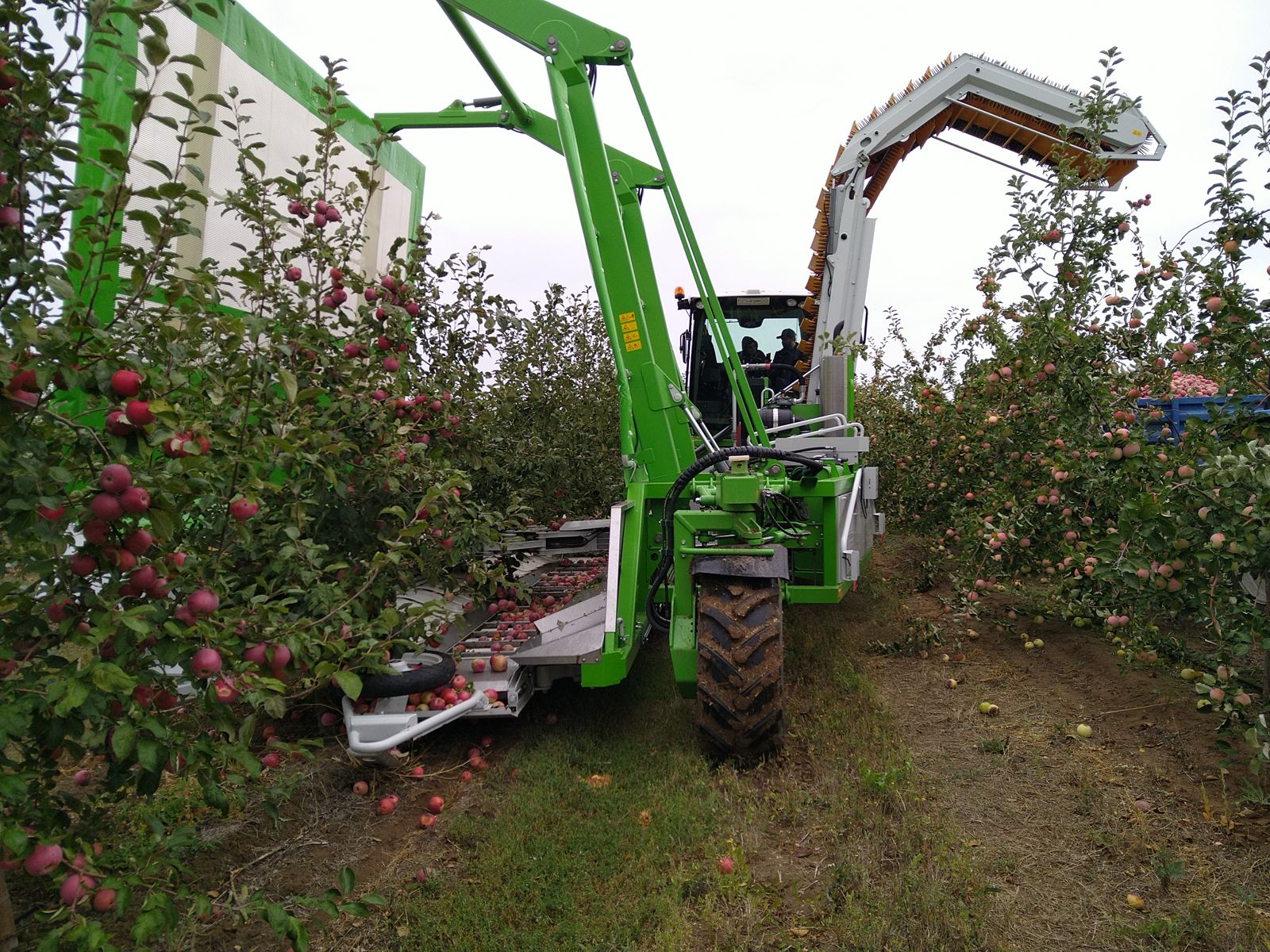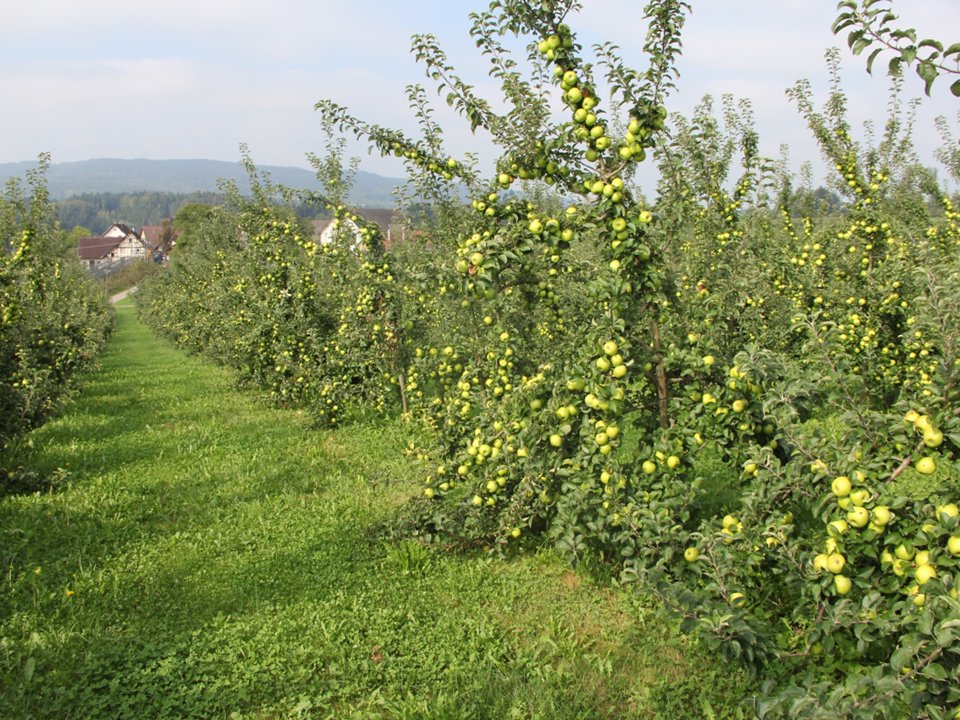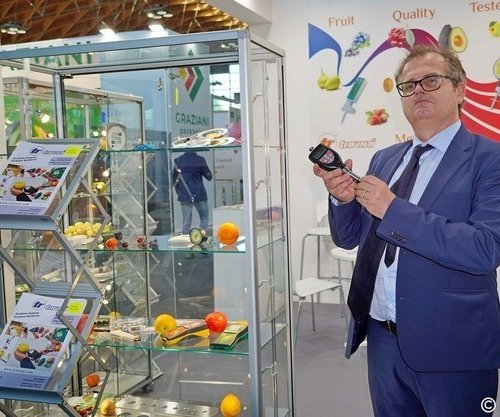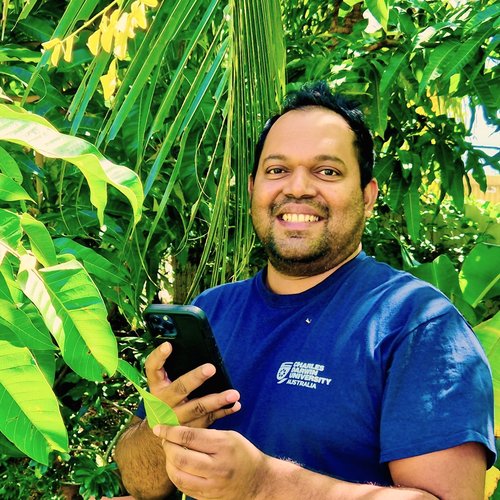By Dr Manfred Büchele Centre of Excellence for Fruit Production, Lake Constance, Ravensburg, Germany.
In the past century, harvest costs for major crops such as grains, oilseeds, corn, and sugar beets have been drastically reduced due to ongoing mechanisation.
However, in the realm of specialty crops, labor requirements for harvesting remain high.
In fruit production, mechanisation has reduced labor inputs in certain tasks, such as pruning, fruit thinning, and crop protection.
For fresh-market apples, harvest productivity has increased to roughly 300kg per labor hour thanks to short-growing, low vigor, narrowly spaced apple trees on dwarfing rootstocks and support equipment such as conveyor belts and automated bin fillers.
Despite long-standing efforts, fully mechanised harvesting of fresh-market apples remains constrained by both technical and economic barriers – even the most advanced robotic systems have not overcome these challenges.
In Germany, harvesting still accounts for more than 50 per cent of labor costs in apple production.
A different approach has been adopted for processing apples used in juice and sauce production.
The industry increasingly demands consistent, well-defined raw material quality.
Traditionally, processing relied on culls – fresh-market apples deemed unsellable.
These are often overly sweet cultivars such as Jonagold, Gala, or Delicious, which lack flavor complexity due to low acid content. Adding citric acid to processed products is a poor compromise for enhancing flavor.
At the Research Center for Fruit Cultivation (KOB) in southern Germany, low-input, cost-effective systems have been developed specifically for processing apples.
These labor-saving systems are gaining traction on larger farms.
Cultivars are selected for their sugar-acid balance and are grafted onto vigorous rootstocks like MM106 or M25.
Overall investment and operating costs are minimised through:
- Low planting density (~320 trees per acre) and simplified trellis systems, compared to 1400-2000 trees/acre on dwarf rootstocks (e.g. M9) for fresh-market production.
- No hail nets, a costly but standard feature in table apple orchards in southern Germany.
- Use of scab-resistant varieties to reduce fungicide use to just 10-20 per cent of conventional levels and lower herbicide requirements.
- Organic certification is easily attainable.
- Mechanical harvesting systems are used instead of manual labor.

Under this extensive system, in Germany processing apples can be produced starting profitablity at prices between $A250-350 per tonne.
Certified organic raw materials may command prices of $A450-600. Multiyear supply contracts are advisable.
Trees typically yield over 80kg per tree starting in year seven and reaching more than 100kg from year nine onward.
The key to productivity is high-quality nursery stock.
One major focus in long-term trials is the growth habit of different cultivars – specifically, upright growth with minimal steep branching.
Rootstock M25 has proven fruitful and well-suited, while MM106 performs well with more vigorous cultivars.
Some tested cultivars displayed biennial bearing tendencies, making them less suitable for extensive systems.
Ammonium thiosulfate or similar thinning agents can mitigate alternation somewhat, though minimal intervention remains the goal. Mechanical thinning with rotary spindle machines such as the Darwin, commonly used in intensive M9 orchards, is not feasible at these tree sizes.
Pruning is limited to removal of large, steep, or competing branches.
Cuts are typically made to short stubs to encourage downward bud regrowth.
In heavy bloom years, mechanical contour pruning can be used to optimise trees for harvesting. In light bloom years, it should be skipped to preserve valuable outer blooms and yield.
Despite reduced inputs, harvest remains a major cost.
KOB tested the performance of the OE-4 – a continuous, mechanical harvesting system using a trunk shaker and catching platform.
Originally developed in East Germany in the 1980s as the OE-1, this system enabled rapid collection of processing apples for socialist state enterprises.
The design emphasised function over comfort and remains remarkably robust when maintained.
In West Germany, these machines were historically unnecessary due to reliance on culls, backyard trees, or old, large trees in traditional orchards.
Hand collection from the ground was standard, though rising wages has made this method uneconomical. In contrast, East Germany developed dedicated processing orchards using MM106 rootstocks.
After reunification, the OE series was modernised into the OE-2 and OE-3.
Unnecessary electronics were avoided in favor of simple, easy-to-maintain components that could be serviced on-farm.
Since 2002, the OE-4 has been a self-propelled, maneuverable machine for orchard use.
The FRUMACO OE-4 wraps a mechanical arm around the trunk and shakes the tree.
Fruit falls onto a catching platform and is conveyed to a trailer driving in the adjacent row. Leaves are removed by blower.
Unlike ground-fall systems common in Europe, the OE-4 prevents fruit-soil contact, offering better hygiene – a potential regulatory concern in the future.
Field trials show harvesting rates of 6–7 trees per minute and the machine can quickly swap to the next trailer when one is full.
It operates in reverse, adjusts to sloped ground, and can be quickly modified for road travel under EU vehicle regulations.
The OE-4 is also usable for tart cherries and other processing fruits.
For softer or smaller fruits, manual placement into bins or on tarps is typically needed to avoid ground contact – not required with the OE-4.
To perform well, the orchard layout must be suitable. Key requirements include:
- Minimum trunk height of 80cm.
- Straight, unobstructed trunks without water sprouts.
- Tree spacing of 2.5m in-row; maximum height of 4.5m.
- No above-ground irrigation, trellising, or major terrain irregularities.
The fruit should ripen uniformly, while the size of the apples is of secondary importance.
Apples should not hang from long, slender branches, as these tend to absorb the shaking motion, making it difficult for the fruit to detach from the tree.
The cost analysis is using conservative European assumptions as the machine has not yet been tested in an orchard in Australia, so academic precision should not be expected.
The essential factor in such calculations is the identification of basic parameters and the farmer’s practical sense for what is necessary and feasible when adapting the presented results to the specific conditions of their orchard.
The machine’s investment is estimated at $A750,000, including shipping and customs. Depreciation is based on 10 years, though expected life exceeds 25–30 years.
Fuel use is $A18,000/year (600 hours), with 2 per cent maintenance, 6 per cent interest on 50 per cent borrowed capital, and operator wage of $A400/day, making the total seasonal cost $A154,500.
The key metric is harvesting capacity.
The work output of 180,000 trees results from 60 harvest days, 10 hours per day, and an average rate of conservative and cautious five trees per minute.
This clearly represents an intensive work schedule, with at least six working days per week.
With a yield of 70kg per tree, the annual campaign performance amounts to 12,600 tonnes harvested from 563 acres.
There are reserves in terms of campaign acreage performance by increasing the rate up to seven trees per minute and achieving higher yields per tree of up to 80kg.
The development of average yields in the trials shows higher production levels from the seventh year onward.
These harvest costs of $154,500 are compared to the actual costs of alternative harvesting technics.
Other benefits such as hygiene, continuous harvest, extended harvest windows, and dual-crop use are harder to quantify but significant.
It can also be used for other processed fruits, if they are not in season at the same time as apples.
Running a two-shift schedule (2 × 8 hours) increases annual output to 900 acres and costs of $A8.91 per tonne.
Regarding the suitability for fruits other than apples or sour cherries for processing, the OE-4 was tested by the manufacturer with respect to its potential applications in harvesting almonds and olives in Aragon (Spain).
The fundamental requirement for these crops is the presence of suitable conditions, such as maximum canopy volume and clear trunk height.
In the case of olives, it was found the crops are less suitable.
The olives do not detach easily from the branches, meaning a significant portion does not fall off.
As a result, traditional methods involving manual work with sticks, rakes, and tools to shake the fruit onto a tarpaulin on the ground must largely be used.
In contrast, the harvesting operations with the OE-4 were very successful for almond crops.
Shaking was carried out at the beginning of the almond's opening.
The almond trees were planted with a 5m alley and 2.5m row spacing while tree heights ranged from 4-5m, and the trunk clearance of 85cm was just sufficient.
However, the dams occasionally found under the trees in Spain, used for water retention, were an obstacle.
Overall, according to the company, work performance of an average of six trees per minute, with some reaching up to seven trees per minute, was achieved.
The shaking process was even more efficient compared to apples.
Practitioners positively noted that the OE-4 features a leveling system and adjustment options for platform height, and it could also move in reverse with the umbrella open, for example, when obstacles needed to be navigated.
The machine was more maneuverable overall. Almond growers also reported lower trunk damage vs. other machines. No additional padding or manual prep was required for the shaker arm.
Since almonds are directly loaded onto trailers, they bypass traditional drying in orchards.
The drying process, as well as the separation of the almond kernel and shell, must take place at a separate location.
The disadvantage of this additional logistical site is outweighed by the benefits of targeted process and quality control as well as hygiene.
The shells can, if desired, be better utilised.
The crops can be accessed earlier for further management measures.
But overall, the harvest is completed one week earlier.
With view to the cost-effectiveness the harvesting season, and therefore the number of harvesting days, is shorter, with 40 days compared to 60 days for apples.
However, the area performance is higher due to the lower number of trees per acre.
In the campaign, 120,000 trees, 600 acres, or 600 tonnes are harvested.
The annual costs for the OE-4 amount to $A140,500.
The author did not find any harvesting costs for Australia and therefore used the ratios from California Alternative savings in harvesting costs are $US465 per acre according to UCCE, University of California, Davis, including transport, with an additional $US220 per acre for harvesting the shells. It is unclear whether the shells are always valued.
From this for Australian conditions, $A400 per acre is derived solely for the shaking operation, including the collection of all harvest components as the work of the OE-4. for Australian conditions
Estimating $A400 per acre saved gives $A240,000 in savings and $A99,500 net profit using the OE-4.
The estimated payback time is 4.3 years. With depreciation ending after 10 years, annual profit increases by $A174,500. In a two-shift system, the numbers improve further.
The OE-4 could also work in pistachios, although trials were not possible due to limited acreage in Spain.
The economic structure and harvest techniques are similar, but harvest periods for almonds and pistachios overlap, limiting shared use potential.
In conclusion, as automated, continuous harvesting becomes viable, processing apple production gains economic appeal – provided large enough acreage is available.
Market demand for high-quality raw material is rising, and the OE-4 presents a well-tested, robust harvesting solution with promising potential for apples, almonds, and pistachios – pending field verification.




